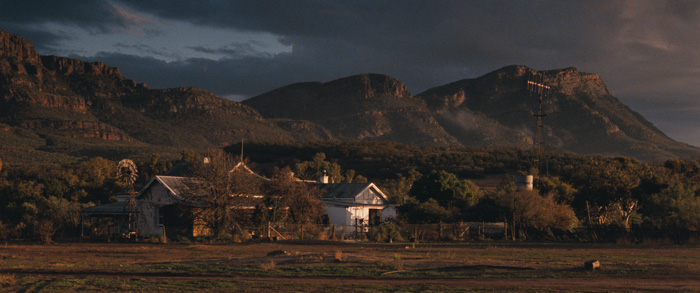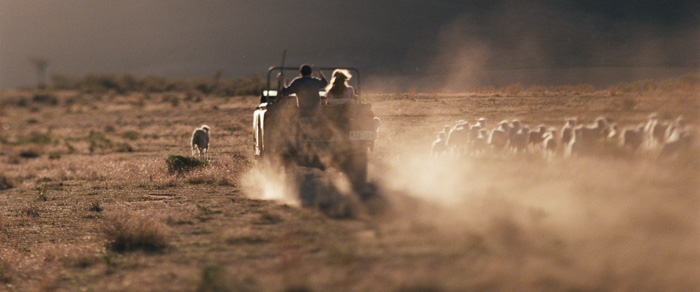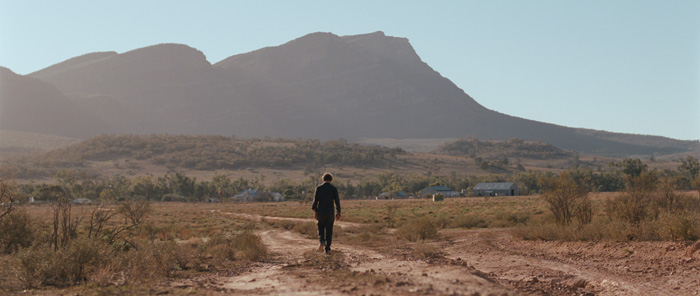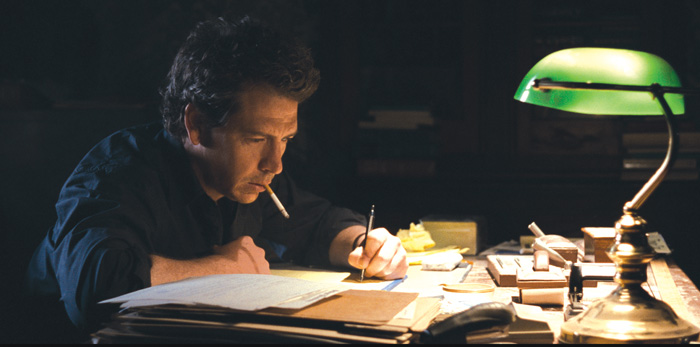| The film was scanned on FSM’s Northlight scanner, and colour graded on their Baselight nonlinear grading system at 2K film resolution.
Looks Reference
Director of Photography Andrew Commis had a vision for ‘Beautiful Kate’ to bring to the screen. “I was striving to make the film’s world feel authentic and at the same time imbue it with a crafted understated look. The heat is overbearing, nights are inky and foreboding and interiors darkened as light searches out details. The stocks I chose were going to be taken to the limits at both ends. I wasn't wanting to ‘play safe’ and fix it in a grade, I wanted it on the neg.”
Fortunately, Director Rachel Ward was willing to let Commis follow up on his intentions, taking his references from the location - bright sunlight contrasting with dim interiors – and from the script, which sets the story in the heat of summer in South Australia. He collected old photos of the area for reference, and Ward also kept a scrapbook of pictures to guide the look of the film.
“I ran through the stocks I had in mind with an exterior and interior set up, plus tested a few others to see if I found any surprises,” said Commis. “The tests were then scanned into the grading system at FSM, where the DI Colourist Billy Wychgel and I were able to pretty comprehensively analyse each stock.”
Testing Stock
Before working at FSM, Billy Wychgel had gained film and photographic knowledge as the colourist on ‘King Kong’ and the last two ‘Lord of the Rings’ films. He went out on location with Andrew for the film tests, some done as stills, completed three or four months ahead of the shoot. Billy was careful not to overgrade the rushes, trying to reveal the variations and potential problems in the stock.
He and Andrew discussed the results and decided to go with different types of Fujifilm, which Andrew had admired in the past for its grain structure and complex colour palette. “I chose the Fujifilm Eterna 64T for exteriors, generally overexposed a stop, 250D for set interiors - location interiors were a mixture of 64T and 250D - and 500T, a particular favourite, for my night work. At the end of the day, though, it's always instinct more than data and numbers,” said Andrew.
Billy said that Andrew had wanted to be able to do a traditional style grade in which the complete story and all details have been captured on the negative. During the shoot, he made deliberate, creative use of light, shadow, contrast and exposure to express his ideas on set about how the film should look. In Billy's view, his efforts were very successful.
Colour Bible
At FSM’s studio, Billy explained that after a film has been edited, he receives the footage from the editors with their EDL. He scans it on the Northlight into the Baselight grading system, which performs the conform to high resolution raw images on the hard drive in the grading suite. Ideally, the next step is a cut-down. This involves taking a shot or two from each scene and, with the Director and DOP, experimenting with looks to create a colour bible or overall plan of how the grade will progress from the beginning to the end of the movie, across interiors, exteriors and locations.
Andrew Commis was an active participant in the colour grade for ‘Beautiful Kate’, which was a bonus. Billy said that fairly often, the DOP and Director aren’t available by the time the edit is finished and the grade can start, which can make it harder to decide which way to go on a grade. DOPs have to get paid for their time, or may have become involved in other projects. But Andrew wanted to contribute, and Billy was able to preserve and work with a lot of the detail and composition Andrew had captured in his footage.
Because Commis had deliberately overexposed some of the sequences shot outdoors in full sunlight, the contrast with the interiors had to be balanced. But some scenes needed surprisingly little intervention. A scene shot in a dance hall with very low lighting and coloured lights looked as though it might have needed work done on it later to bring out the details could, in fact, be virtually left alone.
Colour Control
Billy talked about the control that a colourist has in the grading suite through his ability to affect contrast, coolness and warmth, saturation, day and night and other characteristics on a shot-by-shot basis. By deepening shadows, the grader can obscure details that the photographer may have worked to include in his composition. By highlighting certain areas of the frame, the viewer’s attention can be attracted to or away from an object that the director intended to emphasise, or drawn up to the foreground or away into the background of a shot.
Therefore, he prefers to work with a colour bible, compiled with input from the director when possible, to identify looks and set some limits. The colourist’s starting point is almost always skin and hair tones, because viewers are sensitive to these tones. Blonde hair can sometimes appear greenish on film, for example, which needs to be adjusted.
Effects and Titles
FSM’s post production work on ‘Beautiful Kate’ continued with seamless visual effects. For example, although the story takes place during the summer, the film was shot during the winter, which required changing the light and tones in some scenes, and adding some 3D moths for authenticity. One or two shots needed day-for-night effects to change a day shoot into an evening scene.
Some sky replacements were made, in particular a starry night sky behind a screen of tree branches. Towards the end of the film, the father of the family in the story dies in their home. The camera shifts over to the window in the bedroom and as it begins to drift up through it, the sky the viewer sees there was also replaced. Another dramatic sequence shows the pair of brothers fighting, although the two actors hadn’t been filmed together through the entire scene as it appears in the film.
The movie's distinctive titles were also made at FSM. The design team took handwritten text from Rachel Ward’s scrapbook, written by Bryan Brown, as their inspiration to develop the text for the titles using After Effects, Illustrator and Photoshop.
|
DI Technology at FSM
When FSM purchased their Northlight scanner some years ago, they were the first post house in Australia to buy one. The Northlight scanners, made in the UK, have gained a good reputation and are in use at some major studios around the world such as ILM, Framestore and Cinesite. They scan all film formats, 16 and Super16mm, all 35mm formats, 3 perf, 4 perf and VistaVision. The most recent version handles 4K workflow and digital cinema projection. At FSM, the film frames are scanned to Log DPX files. They remain in that format throughout the whole process, during grading and VFX, until the final rendering is completed to be sent for the filmout. The images are viewed via a Barco DP100 projector.
Another attraction for FSM was that the Northlight’s manufacturer FilmLight produces the Baselight colour grading system with Truelight calibration software as well, which FSM has also purchased, giving consistency across their post production departments. Baselight is a non-linear grading system, which means that, after performing the conform according to the editor’s EDL, all images are available to the colourist at once. Editors, as well as grading technicians, find the Baselight system relatively straightforward to use and understand.
As the main function of a DI is to gather and capture all imagery and assets for a production and normalise their aspect ratio, resolution and colour space, Baselight works with different input and output resolutions and formats, and with linear video and log image sequences. The systems have real-time connectivity for SD, HD and 2K via tape and SAN systems.
Decisions are captured in a database so that projects can be shared. Actions can be modified until the last possible moment, and the conforming system will permit changes to the edit.
FSM now have three Northlight scanners for their DI work and TVC production. Four other post production companies now run Northlights in Australia, three of these in Sydney and one in Adelaide. |
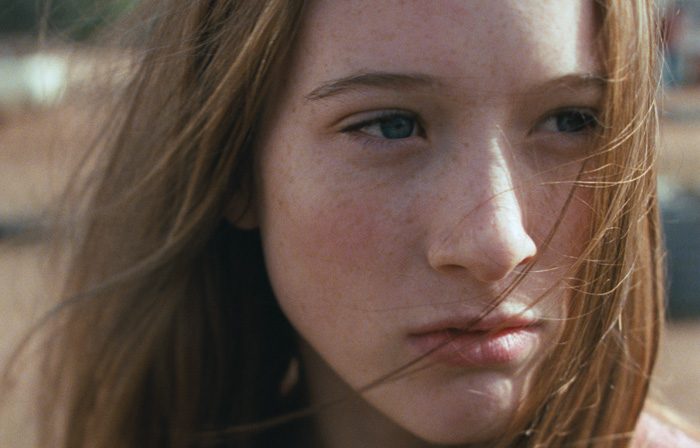 a complete digital intermediate process at FSM Post
a complete digital intermediate process at FSM Post